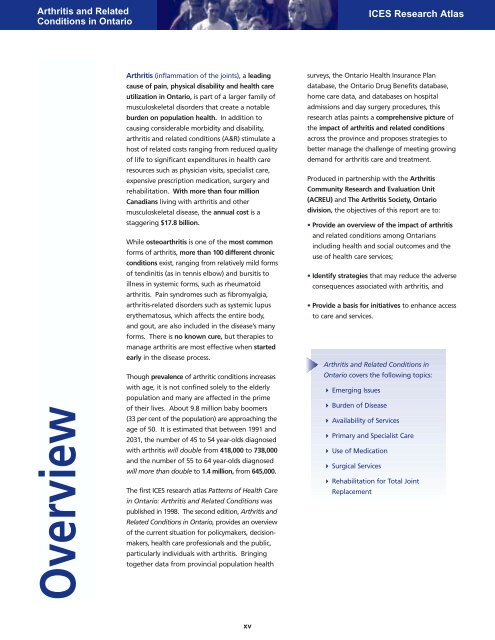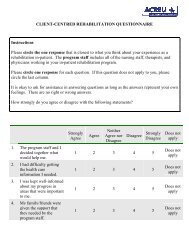Introduction - Arthritis Community Research Evaluation Unit (ACREU)
Introduction - Arthritis Community Research Evaluation Unit (ACREU)
Introduction - Arthritis Community Research Evaluation Unit (ACREU)
You also want an ePaper? Increase the reach of your titles
YUMPU automatically turns print PDFs into web optimized ePapers that Google loves.
<strong>Arthritis</strong> and Related<br />
Conditions in Ontario<br />
ICES <strong>Research</strong> Atlas<br />
Overview<br />
<strong>Arthritis</strong> (inflammation of the joints), a leading<br />
cause of pain, physical disability and health care<br />
utilization in Ontario, is part of a larger family of<br />
musculoskeletal disorders that create a notable<br />
burden on population health. In addition to<br />
causing considerable morbidity and disability,<br />
arthritis and related conditions (A&R) stimulate a<br />
host of related costs ranging from reduced quality<br />
of life to significant expenditures in health care<br />
resources such as physician visits, specialist care,<br />
expensive prescription medication, surgery and<br />
rehabilitation. With more than four million<br />
Canadians living with arthritis and other<br />
musculoskeletal disease, the annual cost is a<br />
staggering $17.8 billion.<br />
While osteoarthritis is one of the most common<br />
forms of arthritis, more than 100 different chronic<br />
conditions exist, ranging from relatively mild forms<br />
of tendinitis (as in tennis elbow) and bursitis to<br />
illness in systemic forms, such as rheumatoid<br />
arthritis. Pain syndromes such as fibromyalgia,<br />
arthritis-related disorders such as systemic lupus<br />
erythematosus, which affects the entire body,<br />
and gout, are also included in the disease’s many<br />
forms. There is no known cure, but therapies to<br />
manage arthritis are most effective when started<br />
early in the disease process.<br />
Though prevalence of arthritic conditions increases<br />
with age, it is not confined solely to the elderly<br />
population and many are affected in the prime<br />
of their lives. About 9.8 million baby boomers<br />
(33 per cent of the population) are approaching the<br />
age of 50. It is estimated that between 1991 and<br />
2031, the number of 45 to 54 year-olds diagnosed<br />
with arthritis will double from 418,000 to 738,000<br />
and the number of 55 to 64 year-olds diagnosed<br />
will more than double to 1.4 million, from 645,000.<br />
The first ICES research atlas Patterns of Health Care<br />
in Ontario: <strong>Arthritis</strong> and Related Conditions was<br />
published in 1998. The second edition, <strong>Arthritis</strong> and<br />
Related Conditions in Ontario, provides an overview<br />
of the current situation for policymakers, decisionmakers,<br />
health care professionals and the public,<br />
particularly individuals with arthritis. Bringing<br />
together data from provincial population health<br />
surveys, the Ontario Health Insurance Plan<br />
database, the Ontario Drug Benefits database,<br />
home care data, and databases on hospital<br />
admissions and day surgery procedures, this<br />
research atlas paints a comprehensive picture of<br />
the impact of arthritis and related conditions<br />
across the province and proposes strategies to<br />
better manage the challenge of meeting growing<br />
demand for arthritis care and treatment.<br />
Produced in partnership with the <strong>Arthritis</strong><br />
<strong>Community</strong> <strong>Research</strong> and <strong>Evaluation</strong> <strong>Unit</strong><br />
(<strong>ACREU</strong>) and The <strong>Arthritis</strong> Society, Ontario<br />
division, the objectives of this report are to:<br />
• Provide an overview of the impact of arthritis<br />
and related conditions among Ontarians<br />
including health and social outcomes and the<br />
use of health care services;<br />
• Identify strategies that may reduce the adverse<br />
consequences associated with arthritis, and<br />
• Provide a basis for initiatives to enhance access<br />
to care and services.<br />
<strong>Arthritis</strong> and Related Conditions in<br />
Ontario covers the following topics:<br />
Emerging Issues<br />
Burden of Disease<br />
Availability of Services<br />
Primary and Specialist Care<br />
Use of Medication<br />
Surgical Services<br />
Rehabilitation for Total Joint<br />
Replacement<br />
xv








